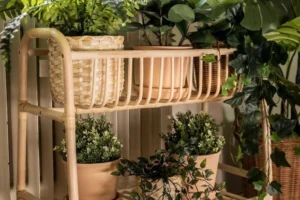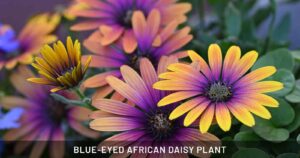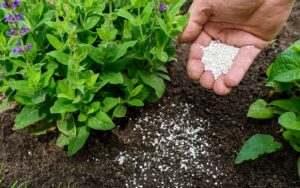Houseplants Safe for Cats and Dogs: The Complete Guide
As a pet owner who loves greenery, finding the perfect balance between beautiful indoor plants and pet safety can be challenging. Many popular houseplants can be toxic to cats and dogs, causing problems ranging from mild irritation to severe illness. The good news is that you don’t have to choose between your green thumb and your furry friends. This comprehensive guide will help you discover and grow pet-safe houseplants that add beauty to your home without endangering your four-legged companions.
Why Pet-Safe Plants Matter
According to the ASPCA Animal Poison Control Center, they receive thousands of calls annually regarding pets who have ingested potentially poisonous plants. The U.S. Food and Drug Administration (FDA) warns that certain plants, like lilies, can cause kidney failure in cats with just a small ingestion.
When you share your home with curious pets who might nibble on your greenery, choosing non-toxic options becomes essential. Even if your pet isn’t typically interested in plants, it’s better to be safe than sorry – especially considering the potential veterinary bills that could result from an accidental poisoning.

15 Pet-Friendly Houseplants for Your Home
Here’s a collection of beautiful, easy-to-grow houseplants that are safe for both cats and dogs:
Low-Maintenance Options for Beginners
1. Spider Plant (Chlorophytum comosum)
The spider plant is possibly the most adaptable and forgiving houseplant for beginners. With its arching variegated leaves and adorable “spiderettes” that dangle from the mother plant, it adds visual interest to any space.
How to grow: Spider plants thrive in bright, indirect light but tolerate lower light conditions. Allow the soil to dry slightly between waterings, and enjoy their rapid growth. They do well in hanging baskets where their trailing babies can cascade downward.
Benefits: Beyond being non-toxic, spider plants are excellent air purifiers, removing formaldehyde and xylene from your indoor environment.
2. Boston Fern (Nephrolepis exaltata)
These classic ferns with their delicate, arching fronds bring a touch of lush greenery to any space. They’re completely safe for pets and make excellent statement plants.
How to grow: Boston ferns prefer high humidity and indirect light. Keep their soil consistently moist (but not soggy) and mist regularly in dry environments. They’re perfect for bathrooms where humidity levels are naturally higher.
3. Calathea (Prayer Plant Family)
With their stunning patterned leaves that move throughout the day (they raise upward at night, resembling hands in prayer), calatheas are both pet-safe and visually striking.
How to grow: Calatheas prefer medium to bright indirect light, consistently moist soil, and high humidity. Avoid cold drafts and direct sunlight, which can damage their distinctive leaf patterns.
Flowering Pet-Safe Houseplants
4. African Violet (Saintpaulia)
These compact flowering plants offer year-round blooms in shades of purple, pink, and white, adding color to your pet-friendly plant collection.
How to grow: African violets prefer bright, indirect light and warm temperatures. Water from the bottom to avoid wetting the leaves, which can cause spotting.
5. Orchids (Phalaenopsis varieties)
Elegant and surprisingly easy to maintain, orchids provide months of stunning blooms and are completely safe around pets.
How to grow: Phalaenopsis orchids prefer bright, indirect light and should be watered only when their specialized potting medium feels dry. Many people find success by giving them three ice cubes once a week.
6. Christmas Cactus (Schlumbergera)
This festive flowering succulent produces colorful blooms during winter months and is safe for your curious pets.
How to grow: Christmas cacti prefer bright, indirect light and should dry out slightly between waterings. To encourage blooming, provide 12-14 hours of darkness for several weeks before their typical flowering period.
Striking Foliage Plants
7. Areca Palm (Dypsis lutescens)
This elegant palm with feathery fronds adds a tropical feel to any room while remaining completely non-toxic to pets.
How to grow: Areca palms prefer bright, indirect light and moderate watering. Allow the top inch of soil to dry between waterings.
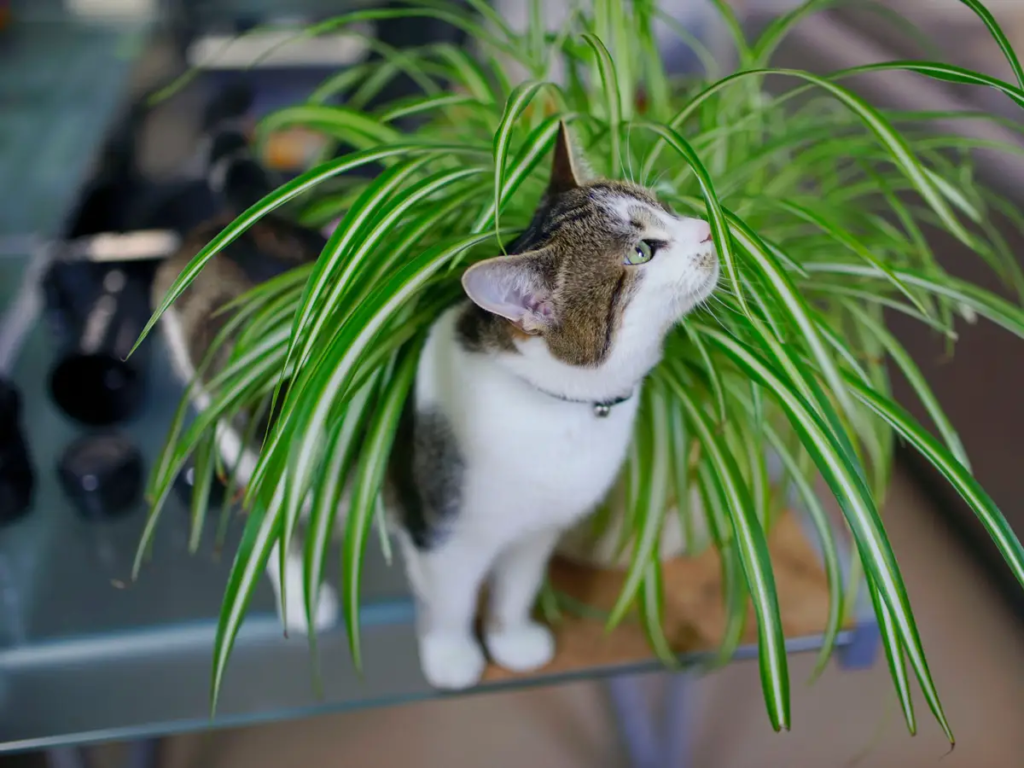
8. Ponytail Palm (Beaucarnea recurvata)
Despite its name, the ponytail palm is actually a succulent with a distinctive bulbous base and long, cascading leaves. Its unique appearance makes it a conversation piece in any room.
How to grow: These drought-tolerant plants prefer bright light and minimal watering. The bulbous trunk stores water, making them forgiving if you occasionally forget to water.
9. Haworthia (Haworthia species)
These small, rosette-forming succulents are perfect for tight spaces and provide the aesthetic appeal of aloe plants without the toxicity concerns.
How to grow: Haworthias prefer bright, indirect light and minimal watering. Allow the soil to dry completely between waterings.
Air-Purifying Options
10. Peperomia (Peperomia species)
Available in various leaf shapes, colors, and patterns, peperomias are compact plants perfect for small spaces.
How to grow: These adaptable plants prefer moderate to bright indirect light and should dry out slightly between waterings. They’re quite tolerant of neglect, making them perfect for busy pet owners.
11. Money Tree (Pachira aquatica)
With its braided trunk and umbrella-like leaf formation, the money tree is both decorative and safe for pets.
How to grow: Money trees prefer bright, indirect light and moderate watering. Let the top couple inches of soil dry between waterings.
12. Bamboo Palm (Chamaedorea seifrizii)
This elegant palm purifies the air while adding a tropical ambiance to your space.
How to grow: Bamboo palms prefer bright, filtered light and consistently moist (but not soggy) soil. They appreciate regular misting in dry environments.
Trailing and Hanging Options
13. Friendship Plant (Pilea involucrata)
These fuzzy-leaved plants with textured foliage make great conversation pieces and are completely pet-safe.
How to grow: Friendship plants prefer moderate to bright indirect light and consistently moist soil. They appreciate humidity, making them good bathroom plants.
14. Swedish Ivy (Plectranthus verticillatus)
Not a true ivy (which is toxic to pets), Swedish ivy has cascading stems that make it perfect for hanging baskets.
How to grow: Swedish ivy thrives in bright, indirect light and should be allowed to dry slightly between waterings. Pinch back regularly to encourage fullness.
15. Staghorn Fern (Platycerium)
These unique epiphytic ferns can be mounted on wood for a striking wall display, safely out of reach of most pets.
How to grow: Staghorn ferns prefer bright, indirect light and weekly watering by soaking their mounting board in water for 10-20 minutes.
Pet-Safe Plants Comparison Table
| Plant Name | Light Needs | Watering | Difficulty Level | Special Features |
|---|---|---|---|---|
| Spider Plant | Medium to bright indirect | Allow to dry between waterings | Easy | Air-purifying, produces babies |
| Boston Fern | Medium indirect | Keep consistently moist | Moderate | High humidity lover, lush appearance |
| African Violet | Bright indirect | Water from bottom when dry | Moderate | Year-round flowering potential |
| Areca Palm | Bright indirect | Moderate, dry between | Moderate | Elegant, tropical appearance |
| Money Tree | Bright indirect | Allow to dry between waterings | Easy | Braided trunk, symbolic of prosperity |
| Calathea | Medium indirect | Keep consistently moist | Moderate-difficult | Leaves move throughout day, patterned foliage |
| Orchid | Bright indirect | Minimal, specialized method | Moderate | Long-lasting exotic blooms |
| Christmas Cactus | Bright indirect | Allow to dry between waterings | Easy | Winter blooming, long-lived |
| Ponytail Palm | Bright light | Minimal, drought-tolerant | Easy | Distinctive appearance, very forgiving |
| Haworthia | Bright indirect | Minimal, succulent | Easy | Compact, aloe-like appearance |
Signs Your Pet May Have Ingested a Toxic Plant
Even with the best precautions, accidents can happen. Here are symptoms that might indicate your pet has consumed a toxic plant:
- Drooling or foaming at the mouth
- Vomiting or diarrhea
- Difficulty breathing
- Lethargy or weakness
- Loss of appetite
- Rash or irritation around the mouth
- Unusual behavior or disorientation
If you notice any of these symptoms, contact your veterinarian immediately. For emergencies, you can also call the ASPCA Animal Poison Control Center at (888) 426-4435.
Common Toxic Plants to Avoid
While focusing on safe options is important, being aware of the most dangerous plants can help you make informed decisions. Never bring these toxic plants into a home with pets:
- Lilies (especially true lilies, extremely toxic to cats)
- Sago palm
- Pothos/Devil’s ivy
- Philodendron
- Aloe vera
- Peace lily
- Dieffenbachia
- English ivy
- Jade plant
- Snake plant/Mother-in-law’s tongue
Tips for Growing Pet-Safe Plants Successfully
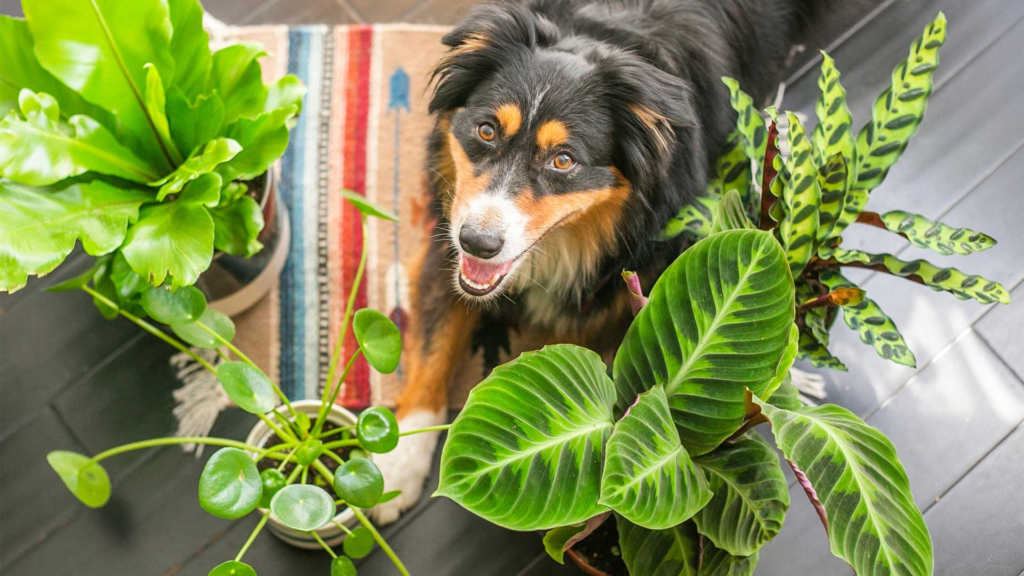
Proper Placement
Consider your pet’s habits when placing your plants. Even non-toxic plants can cause digestive upset if consumed in large quantities. For persistent plant-chewers, try these strategies:
- Use hanging planters or tall plant stands
- Create designated “plant rooms” that remain off-limits to pets
- Place deterrents like aluminum foil or citrus peels around plant bases
- Provide pet grass (cat grass/wheat grass) as an alternative for chewing
Potting and Soil Considerations
Choose sturdy, heavy pots that won’t easily tip over when bumped by curious pets. Consider pot material as well—some glazed ceramic pots contain lead, which can be harmful if chewed.
For soil, consider covering the surface with larger decorative stones to prevent digging and soil consumption, which can cause digestive blockages.
Fertilizing Safely
Many commercial fertilizers contain chemicals that can be harmful to pets if ingested. Opt for organic alternatives or dilute commercial fertilizers more than recommended. Better yet, use these pet-safe fertilizing methods:
- Compost tea (steeped well-aged compost)
- Diluted liquid seaweed extract
- Worm castings as a soil amendment
Always follow package directions carefully and keep fertilizer products stored securely away from pets.
Creating a Pet-Friendly Indoor Garden
With proper planning, you can create a lush indoor garden that’s safe for your four-legged family members:
- Layer different plants for visual interest – Combine hanging plants, tabletop varieties, and floor specimens at different heights.
- Group plants with similar care needs – This simplifies maintenance and creates appealing “plant vignettes” throughout your home.
- Incorporate pet-friendly herbs – Plants like basil, rosemary, and mint are safe for pets and useful in cooking.
- Consider alternate plant displays – Wall-mounted plants, terrariums, and closed glass cabinets can protect particularly tempting plants while adding stylish elements to your décor.
- Monitor new additions carefully – When introducing new plants, watch how your pets interact with them before leaving them unattended.
Conclusion
Creating a pet-friendly plant paradise in your home doesn’t require compromising on style or variety. By selecting from the wide range of non-toxic options available and taking some simple precautions in placement and care, you can enjoy all the benefits of houseplants while keeping your furry friends safe.
Remember that individual pets may have sensitivities even to plants considered generally safe, so always monitor new introductions closely. When in doubt about a particular plant’s safety, consult resources like the ASPCA’s toxic plants database or check with your veterinarian.
With the right knowledge and plants, you can create a lush, green environment that both you and your pets can safely enjoy for years to come.

